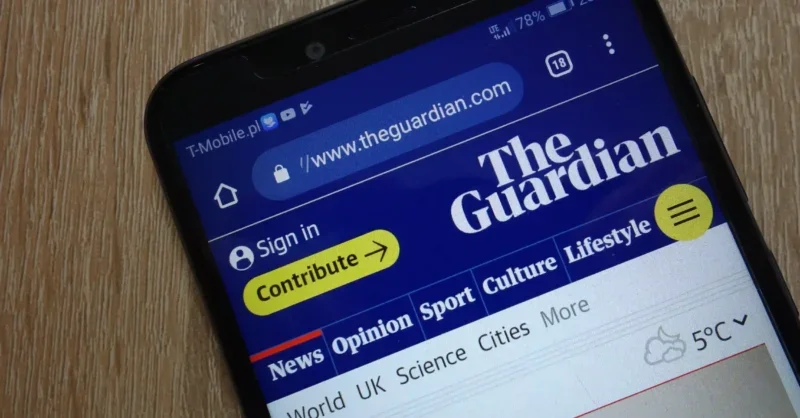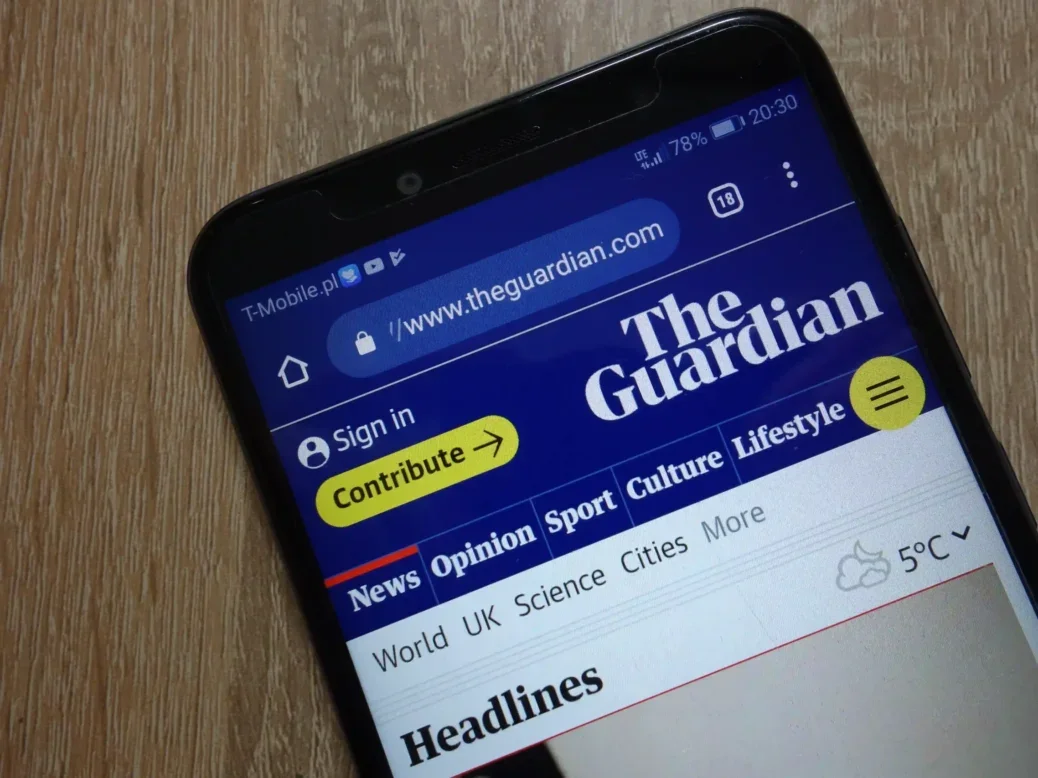News
Most popular websites for news in the UK: Monthly top 50 listing


The Guardian was the biggest commercial news website in the UK in August, overtaking the likes of The Sun and Mail Online in Press Gazette’s monthly ranking.
The Guardian had an audience of 21.8 million people in the UK in August, according to Ipsos iris data analysed by Press Gazette. This was a slight dip since July of 1% but year-on-year growth of 1%.
The Guardian has frequently sat in around fifth place in our monthly ranking, behind the BBC, The Sun, Mail Online and the Mirror. It has also at times been overtaken by Sky News or The Independent.
Nine of the ten biggest news websites in the UK in August saw month-on-month decline after a busy news month in July that included the UK election results and new Labour government, a mass stabbing at a Taylor Swift dance class in Southport that led to days of rioting across England, Joe Biden stepping down from the US presidential race, and an assassination attempt on Donald Trump.
The only top-ten news website that grew between July and August was Yahoo!, up 4% to an audience of 17 million in August.
Six of the ten biggest news websites did see their audience grow compared to August 2023.
Content from our partners
But The Sun and Mail Online, which have traditionally battled it out as the biggest non-BBC news website in the UK, both saw decline.
The Sun was down 10% month-on-month and 7% year-on-year to 21.3 million while Mail Online was down 5% and 9% respectively to 21.1 million.
Three other news websites were close behind including Sky News which in July leaped from sixth to third place in our monthly ranking. In August the broadcaster’s website was down 10% month-on-month but up 15% compared to last August, reaching 20.5 million.
After Sky News was The Independent (20.5 million) and the Mirror (20 million).
To create this list, Press Gazette used Ipsos’ ranking of the top online brand groups and selected the 50 biggest that Press Gazette considers to be based in journalistic content of any genre.
The Ipsos iris data measures the total unduplicated number of people who used a brand’s websites and apps in a given month and includes all traffic, not necessarily just news. Reach and minutes for brands such as the BBC, ITV and Channel 4, which have a strong entertainment offering in addition to news content, will therefore be higher.
Just ten news websites across the entire top 50 recorded growth between July and August.
The biggest growth was at Business Insider (shown in the data as Springer Insider) and politics site Joe, both up month-on-month 22.5% to 4.1 million and 2.9 million respectively.
The biggest month-on-month decline in August was at Reach regional Gloucestershire Live, down 26% to 3 million, followed by ITV, down 25% to 12.6 million.
However Gloucestershire Live continued a run of growth when compared to 2023, up 152% year-on-year. It was followed by Tech Radar (up 95% to 3.8 million) and Forbes (up 94% to 7.7 million).
Audiences once again spent the most time with the BBC (9.7 billion minutes) followed by Yahoo! (1.8 billion) and Mail Online (1.5 billion). The same trio was top for page views, on 2.9 billion, 1.2 billion and 546 million respectively.
To create this top-50 list, Press Gazette used Ipsos’ ranking of the top online brand groups and selected the 50 biggest that Press Gazette considers to be based in journalistic content. Our list covers both consumer and industry (B2B) media. You can consult our list of 100 brands and read more about our criteria here.
Brands such as Apple and Google, while well-known names in news, are excluded from our list given the wide reach of their non-news content. Google News and Apple News are not reported by Ipsos as separate entities in brand level data.
Ipsos iris replaced Comscore as the industry-recognised standard in 2021. Ipsos iris data is partly derived from a panel of 10,000 people aged 15 and over that is designed to be nationally representative. The participants have meters installed across 25,000 personal devices to passively measure website and app usage. This is combined with data from participating websites that are tagged so all devices visiting the site can be identified and logged.
July 2024
Sky News leaped up the ranking of the biggest news websites in the UK in July, moving from sixth to third place in Press Gazette’s monthly ranking.
Sky News reported month-on-month growth of 10% and year-on-year growth of 22% for a monthly audience of 22.7 million people.
It was behind only the BBC (whose domain includes its entertainment content and not just news) on 40.3 million (up 3% month-on-month and 6% year-on-year) and The Sun on 23.7 million (up 1% compared to June and down 2% compared to July 2023).
Mail Online (22.2 million) returned to its former place ahead of the Mirror (22.1 million) after the Reach tabloid overtook it last month. They are now in fourth and fifth place respectively.
In a busy news month – July saw the attempted assassination of Donald Trump, Joe Biden stepping down as presidential candidate, the UK general election, the end of the Euros and the start of the Olympics – 37 of the websites in our top 50 saw month-on-month growth, and 34 saw year-on-year growth.
Of the top ten biggest sites in July, six sites saw month-on-month growth and seven saw annual rises. Sky News and The Guardian (22 million) were both up 10% month-on-month, while on an annual basis The Telegraph led the way (18.3 million, up 32%).
Four of the top ten websites reported double-digit year-on-year growth, the same number as in June.
Conclusions should not be drawn regarding changes in places for publishers outside the top ten in this month’s list because Press Gazette has revised and slightly altered the websites included in the analysis.
To create this list, Press Gazette used Ipsos’ ranking of the top online brand groups and selected the 50 biggest that Press Gazette considers to be based in journalistic content of any genre.
The Ipsos iris data measures the total unduplicated number of people who used a brand’s websites and apps in a given month and includes all traffic, not necessarily just news. Reach and minutes for brands such as the BBC and ITV, which have a strong entertainment offering in addition to news content, will therefore be higher.
The biggest dips compared to the prior month were at Radio Times (5.8 million) and Reach regional website Gloucestershire Live (4 million), both down 8%.
Year-on-year, the top three audience declines were also Reach websites: Examiner Live (audience of 3.2 million, down 42%), Chronicle Live (3.6 million, down 25%) and the Daily Star (5.5 million, down 24%).
The biggest growth compared to June was at tech website Toms Guide (audience of 3.1 million, up 27%) and Reuters (4.3 million, up 24%).
Year-on-year, Gloucestershire was up 301% despite its more short-term dip. Forbes was up 129% to 7.5 million.
The Times and Sunday Times website (11.6 million) had a smaller audience in July than the Manchester Evening News (12.2 million), Birmingham Live (11.9 million) and Evening Standard (11.8 million) which were all smaller than the national brand in July 2023.
After a run of growth following its move to a .com website in March 2023, the GB News website (audience of 9.2 million) is now bigger than those of DMGT’s the i (9 million) or The New York Times (8.3 million).
Audiences spent the most time with the BBC (10.5 billion minutes) followed by Yahoo! (1.8 billion) and Mail Online (1.6 billion). The same trio was top for page views, on 3.2 billion, 1.3 billion and 574 million respectively.
The biggest month-on-month growth in minutes spent was at ITV (up 77% to 1.4 billion) followed by Hello! Magazine (up 20% to 42 million) and Unilad (up 18% to 5.7 million). The biggest drop was at CNN (down 26% to 15 million minutes).
Compared to July 2023, however, Unilad was down by three-quarters making it the biggest year-on-year drop. It was followed by Good Housekeeping (down 65% to 4.5 million) and the Daily Star (down 57% to 14.7 million).
Forbes almost doubled its monthly minutes in the past year, rising by 99% to 12.4 million in July. It was followed by Gloucestershire Live (up 85% to 6.7 million) and The New York Times (up 67% to 366 million minutes).
June 2024
The Mirror overtook Mail Online to become the UK’s third biggest newsbrand in June, according to Press Gazette’s latest ranking.
Monthly audience to Reach-owned Mirror was up 2% month-on-month to 22.5 million, helping it edge past Mail Online (audience of 22.3 million, down 3%), which before this month regularly occupied a top three spot in our ranking.
The Mirror also saw a smaller year-on-year decline than Mail Online, with the monthly audience to the news sites down 1% and 9% respectively compared to June 2023. For the Mail this was the largest annual decline in the top ten sites.
Mail Online also saw a large drop for the second consecutive month for minutes spent, according to data from Ipsos iris – down 4% month-on-month and 29% year-on-year to 1.4 billion minutes – now the joint second highest total minutes alongside ITV which grew by 77% month-on-month and 39% year-on-year.
A statement shared with Press Gazette by Mail Online publisher DMG Media said: “The seriously popular Mail Online is now bigger than ever before – bringing in hundreds of millions of readers, viewers and listeners with its unique blend of addictive content.
“The brand remains the number one commercial publisher for engagement, with substantially more page views and time spent on the website and app than any of its competitors.
“This once again demonstrates our exceptionally loyal and engaged audience, who in turn have enabled us to successfully launch a subscription proposition in recent months.
“We are also dominating on Snapchat, Tiktok and Facebook, have a portfolio of award-winning podcasts and are releasing a new slate of original shows as we look to take Youtube by storm.
“The Mail has never had more users consuming its content across multiple platforms and looks forward to these significant milestones being recognised in future releases.”
The BBC remained top of the table as the newsbrand with the largest monthly audience in the UK, followed by The Sun (audience of 23.5 million) in second place, the Mirror in third, Mail Online in fourth and The Independent (21.1 million) in fifth – with The Guardian knocked out of fifth place into seventh (audience of 20.1 million) also behind Sky News (20.6 million).
The Ipsos iris data measures the total unduplicated number of people who used a brand’s websites and apps in a given month and includes all traffic, not necessarily just news. Reach and minutes for brands such as the BBC and ITV, which have a strong entertainment offering in addition to news content, will therefore be higher.
By month-on-month growth, June was also a strong month for ITV (audience of 17 million, up 15% compared to May), The Telegraph (17.2 million, up 14%) and Sky News (up 4%), which were the three fastest-growing names among the top ten newsbrands by audience size. As a result, ITV, which re-entered the top ten newsbrands by size of monthly audience in May in tenth position, climbed a further place to ninth in June in a month of position shifts at the top.
Four top ten newsbrands by audience size saw double-digit year-on-year growth in June: Metro (audience of 15.9 million, up 22%), The Telegraph (up 18%), Sky News (up 12%) and ITV (up 10%). The BBC was the remaining top ten newsbrand to see year-on-year growth in June as its audience was up 4% to 39.1 million.
For Metro, Sky News and ITV, June follows a similarly strong year-on-year performance in May, while The Telegraph, which saw its audience fall last month, reversed its fortunes.
Among the wider top 50, Reach’s Gloucestershire Live was again the fastest-growing newsbrand year-on-year. Audience to Gloucestershire Live was up 356% to 4.4 million people, followed by Forbes (6.6 million, up 95%) and Screenrant (4 million, up 63%).
Month-on-month among the whole top 50, LBG Group’s Unilad grew fastest (4 million, up 19% compared to May), followed by ITV, The Telegraph and Time Out (4.4 million, up 10%).
Audiences spent most time with the BBC (9.2 billion minutes) while The Guardian fell from third place behind Mail Online into fourth (898.5 million minutes) due to ITV’s growth.
As well as Mail Online, its rival The Sun (348.4 million minutes, down 31%) and The Guardian (down 19%) both saw large year-on-year falls in minutes spent with their content.
In contrast, paywalled brands continued to demonstrate strong growth in time spent. Audiences spent 810.3 million minutes with The Telegraph (up 38% year-on-year, surpassing its 23% growth in May), 569.8 million with The Times (up 38%) and 365.8 million with The New York Times (up 67%).
To create this top-50 list, Press Gazette used Ipsos’ ranking of the top online brand groups and selected the 50 biggest that Press Gazette considers to be based in journalistic content. Our list covers both consumer and industry (B2B) media. You can consult our list of 100 brands and read more about our criteria here.
Brands such as Apple and Google, while well-known names in news, are excluded from our list given the wide reach of their non-news content. Google News and Apple News are not reported by Ipsos as separate entities in brand level data.
Ipsos iris replaced Comscore as the industry-recognised standard in 2021. Ipsos iris data is partly derived from a panel of 10,000 people aged 15 and over that is designed to be nationally representative. The participants have meters installed across 25,000 personal devices to passively measure website and app usage. This is combined with data from participating websites that are tagged so all devices visiting the site can be identified and logged.
May 2024
ITV re-entered the top ten for audience reach among UK news websites in May, according to Press Gazette’s latest ranking.
Metro saw the biggest year-on-year growth in reach among the top ten newsbrands but Sky News was second by that metric as well as top of the month-on-month growth chart.
And on engagement, Mail Online and The Sun both saw drops of more than 30% in minutes spent compared to May last year.
Audience to the Metro website was up 17% year-on-year in May to 16.1 million people, according to data from Ipsos iris.
It was followed by Sky News which also saw 10% growth compared to May 2023 to reach 19.7 million people.
In contrast, Mail Online (23 million, down 9% year-on-year) and The Telegraph (15.1 million, down 7%) saw the biggest falls among the top ten newsbrands by UK audience size.
Month-on-month, the broadcasters also had a strong May with Sky News and ITV (14.8 million) topping the table for audience change among the top ten names, growing 9% compared to April.
As a result, ITV re-entered the top ten sites by size of monthly audience in tenth place, edging Money Saving Expert down into twelfth position (audience of 14.1 million) behind the Daily Express (14.8 million) in eleventh. The rest of the top ten remained unchanged in a largely static month at the top.
The Mirror (audience of 22.1 million, up 6% month-on-month), BBC (39.1 million, up 4%), The Sun (23.9 million, up 2%) and Mail Online (up 2%) were the remaining four top-ten newsbrands to reach more people in May than April
The BBC was unmoved from the top of the table as the newsbrand with the largest monthly audience in the UK, followed by The Sun in second place and Mail Online in third.
Among the wider top 50, Reach’s Gloucestershire Live and Irish Mirror were again the fastest-growing newsbrands year-on-year. Audience to Gloucestershire Live was up 293% to 4 million people, while the Irish Mirror was up 183% to 3.4 million.
Business title Forbes doubled its audience (up 100% to 6.8 million) while entertainment newsbrand Joe also performed well in May with its audience rising to 3 million, up 78% year-on-year.
Screenrant (up 54% year-on-year), Bristol Live (up 51%), Financial Times (up 47%), Birmingham Live (up 37%), TechRadar (up 30%) and the New York Times (up 20%) also grew in what was a strong month for many newsbrands – only 13 of the top 50 saw an audience drop compared to last May.
Month-on-month among the whole top 50, Gloucestershire Live was again the top performer (up 38%), followed by Unilad (3.4 million, up 32%) and the Financial Times (4.5 million, up 28%).
Audiences spent most time with the BBC (9.4 billion minutes) followed by Mail Online (1.5 billion minutes) and The Guardian (969.5 million minutes).
Mail Online saw a large year-on-year fall in time spent with its content – down 30% compared to May 2023, as did rival The Sun (316.2 million minutes, down 39%).
In contrast, paywalled brands continued to demonstrate strong growth in time spent with their content. Audiences spent 761.4 million minutes with the Telegraph (up 23% year-on-year), 565.5 million with the Times & Sunday Times (up 40%) and 379.8 million with the New York Times (up 66%).
To create this top-50 list, Press Gazette used Ipsos’ ranking of the top online brand groups and selected the 50 biggest that Press Gazette considers to be based in journalistic content. Our list covers both consumer and industry (B2B) media. You can consult our list of 100 brands and read more about our criteria here.
Brands such as Apple and Google, while well-known names in news, are excluded from our list given the wide reach of their non-news content. Google News and Apple News are not reported by Ipsos as separate entities in brand level data.
April 2024
The Independent fell back to sixth place in Press Gazette’s latest ranking of the biggest news websites in the UK after a strong March that saw it overtake the Mirror and The Guardian.
The Independent’s UK audience fell by 5% month-on-month in April to 19.7 million, according to the latest Ipsos iris data.
Meanwhile the Mirror moved back into fourth (audience of 21 million, up 1% month-on-month) and Guardian back into fifth (20.5 million, down 2% month-on-month).
DMGT’s Metro was however, the only top ten brand to see significant growth in audience compared to March, and was the fastest-growing top ten newsbrand in the UK, with its monthly audience up 15% year-on–year to 16.4 million people.
The Telegraph (15.9 million, up 3%) and Money Saving Expert (up 1%) were the remaining top ten newsbrands to make month-on-month gains.
Metro was also the fastest-growing newsbrand year-on-year with audience up and 16% compared to April 2023.
Second-fastest growing year-on-year was Martin Lewis’ consumer newsbrand Money Saving Expert (audience of 13.9 million, up 6%) while Sky News (18.1 million, up 2%) was third.
They were the only three top ten names to grow year-on-year in April. Instead several well-known names, among them Mail Online (audience of 22.5 million, down 9.1%), The Sun (23.4 million, down 11%) and the Mirror (21 million, down 13%), saw significant drops.
The BBC was unmoved from the top of the table as the newsbrand with the largest monthly audience in the UK at 37.8 million people, followed by The Sun in second place and Mail Online in third.
Among the wider top 50, Reach’s Gloucestershire Live and Irish Mirror both more than doubled their audiences compared to April last year. Audience to Gloucestershire Live was up 184% to 2.9 million, while the Irish Mirror’s audience was up 152% to 3.3 million.
A number of other newsbrands also saw growth of over 50% year-on-year in April, among them Forbes (audience of 6.7 million, up 86% year-on-year), People (3 million, up 76% and Future-owned Tech Radar (3.6 million, up 58%).
Many of the same names also performed strongly month-on-month with visitors to the Irish Mirror up 34% compared to March, up 27% at Forbes and up 24% at Tech Radar.
Looking at engagement, audiences spent most time with the BBC (9.4 billion minutes) followed by Mail Online (1.5 billion minutes) and The Guardian (904 million minutes) although the latter fell below the one billion mark.
Paywalled brands again punched above their weight on time spent with their content compared to the size of their total reach with The Telegraph ranked eighth for reach but coming fifth for time spent at 762.4 million minutes – up both month-on-month (6%) and year-on-year (61%).
The Times and Sunday Times, which ranked 13th for audience, came in sixth for a second month in a row by total time spent with its digital content (599.5 million minutes).
To create this top-50 list, Press Gazette used Ipsos’ ranking of the top online brand groups and selected the 50 biggest that Press Gazette considers to be based in journalistic content. Our list covers both consumer and industry (B2B) media. You can consult our list of 100 brands and read more about our criteria here.
Brands such as Apple and Google, while well-known names in news, are excluded from our list given the wide reach of their non-news content. Google News and Apple News are not reported by Ipsos as separate entities in brand level data.
March 2024
The Independent’s audience was up 8% month-on-month in March, leading to it jumping from sixth to fourth place in Press Gazette’s latest monthly ranking of the biggest news websites in the UK.
The Independent’s monthly audience was up to 21 million, meaning it has leapfrogged the Mirror (20.7 million) and The Guardian (20.8 million) to reach fourth place for the first time since Press Gazette started using Ipsos iris data for this ranking.
The Mirror fell from fourth to sixth place, with a month-on-month drop of 3% compared to The Guardian’s 2% growth.
The Independent’s growth was the joint-highest in the top ten with The Telegraph in ninth place, which was also up 8% month-on-month to 15.5 million.
Mail Online (audience of 22.7 million, up 6%) and Metro (14.3 million, up 5%) also saw audiences that were at least 5% bigger than in February. ITV (audience of 14 million) and the Mirror saw the biggest falls, at 3% each.
Year-on-year, the UK’s biggest newsbrands saw a much slower month with all but The Independent (up 8% year-on-year) seeing smaller audiences in March 2024 compared with the same month in 2023.
ITV (down 18% year-on-year), Mirror (down 17%), Metro (down 15%), The Sun (audience of 23.7 million, down 15%) and The Guardian (down 14%) all saw-double digit drops.
Among the wider top 50, Gloucestershire Live, ranked 39th, more than doubled its audience year-on-year reaching 3.9 million people – up 139% compared to March 2023.
It was followed by Forbes (5.3 million, up 44% year-on-year) and Canadian-based entertainment news site Screenrant (3.9 million, up 38%).
Reach regional sites, Bristol Live (audience of 4.9 million, up 8%) and Birmingham Live (11 million, up 7%) saw the next biggest year-on-year growth.
We have not included GB News in the above chart. Its audience was up 3,515% year-on-year however, this is due in part to the fact that GB News launched a new dotcom URL last year meaning that not all growth will be organic.
Compared to February, women’s lifestyle publisher Cosmopolitan saw the largest boost to its audience – up 42% month-on-month to 3.8 million.
It was followed by Yorkshire Live (4.9 million, up 33%) and CNN (3.5 million, up 31%). Yorkshire Live (also known as Examiner Live) was one of five Reach websites, three of which are regional brands, in the fastest-growing sites month-month, along with OK (5.2 million, up 23% month-on-month), Gloucestershire Live (up 15%), Daily Express (13.2 million, up 13%) and Manchester Evening News (11 million, up 13%).
The BBC remained top of the table for overall audience (38 million), although Ipsos’ data measures the total unduplicated number of people who used a brand’s websites and apps in a given month and includes all traffic, not necessarily just news. Reach and minutes for brands such as the BBC and ITV, which have a strong entertainment offering in addition to news content, will therefore be higher.
The Sun was again the second largest newsbrand and the top commercial name (23.7 million), followed by Mail Online.
Audiences also spent most time with the BBC (9.4 billion minutes), followed by Mail Online (1.6 billion minutes) and The Guardian (1 billion minutes).
The Guardian overtook ITV (893 million minutes) which fell into fourth place. Total time spent with The Guardian was up 29% year-on-year and 5% month-on-month. ITV in contrast recorded a 25% fall compared to February.
Paywalled brands again punched above their weight on time spent with their content compared to the size of their total reach with The Telegraph coming fifth for time spent (719 minutes) compared to eighth for reach.
The Times and Sunday Times, which ranked 13th for audience, came in sixth for total time spent with its digital content (633.2 million minutes), up one place from February, while The New York Times, ranked 23rd for audience reach, came in eighth for minutes spent (371.5 million).
To create this top-50 list, Press Gazette used Ipsos’ ranking of the top online brand groups and selected the 50 biggest that Press Gazette considers to be based in journalistic content. Our list covers both consumer and industry (B2B) media. You can consult our list of 100 brands and read more about our criteria here.
Brands such as Apple and Google, while well-known names in news, are excluded from our list given the wide reach of their non-news content. Google News and Apple News are not reported by Ipsos as separate entities in brand level data.
February 2024
None of the ten biggest news websites in the UK saw a bigger audience in February than in January, according to Press Gazette’s latest monthly ranking.
ITV saw the biggest fall among the top sites by audience size, down 7% compared to January (14.4 million) according to data from Ipsos iris. It was followed by Mail Online (audience of 21.4 million), Sky News (17.7 million) and the Mirror (21.3 million), which each saw a 6% month-on-month fall in audience.
This trend was in contrast to January, when all but three of the top ten newsbrands grew their audiences month-on-month.
Year-on-year the picture was the same for the top ten brands with each recording declines compared to last February. Seven saw double-digit drops including Metro (with 13.6 million unique visitors in February) seeing the largest year-on-year fall at 15%. Sky News, the Guardian (audience of 20 million) and the BBC (37.6 million) saw falls of less than 10%.
Among the wider top 50, a Reach regional newsbrand recorded the largest month-on-month growth in audience for the second month in a row. Audience to Gloucestershire Live was up 20% in February to 3.4 million, echoing Bristol Live’s gain in January, and leading to it re-enter the top 50 in 37th place. LBC (audience of 4.3 million) shared first spot with Gloucestershire Live, also up 20% month-on-month.
They were followed by Irish Mirror (audience of 2.7 million, up 16% month-on-month) and another Reach brand, Yorkshire Live (3.7 million, up 13%).
Two newsbrands just outside of the top ten, The Evening Standard (ranked 15 with an audience of 10.9 million, up 9% month-on-month) and The Times and Sunday Times (rank 12, 12.1 million, up 5%), also grew monthly in February.
Year-on-year, relative newcomer GB News, which launched a dotcom url last year, saw the fastest growth in the top 50. Audience to the newsbrand was up 167% compared to February 2023 at 9 million people. It was followed by Gloucestershire Live (up 130% year-on-year) and People (2.9 million, up 59%).
The BBC remained top of the table for overall audience, although Ipsos’ data measures the total unduplicated number of people who used a brand’s websites and apps in a given month and includes all traffic, not necessarily just news. Reach and minutes for brands such as the BBC and ITV, which have a strong entertainment offering in addition to news content, will therefore be higher.
The Sun remained the second largest newsbrand and the top commercial name (23.4 million), followed by Mail Online (21.4 million), the Mirror (21.3 million), and The Guardian (20 million) in an order unchanged from last month.
Audiences also spent most time with the BBC (10.7 billion minutes), followed by Mail Online (1.6 billion minutes), and ITV (1.2 billion minutes), with BBC and Mail Online both seeing falls of 11% and 12% respectively in time spent with their content compared to January.
Paywalled brands again punched above their weight on time spent with their content compared to the size of their total reach. The Times and Sunday Times, which ranked 12th for audience, came in seventh for total time spent with its digital content (572.6 million minutes), while The New York Times, ranked 21st for audience reach, came in ninth for minutes spent (323.6 million).
To create this top-50 list, Press Gazette used Ipsos’ ranking of the top online brand groups and selected the 50 biggest that Press Gazette considers to be based in journalistic content. Our list covers both consumer and industry (B2B) media. You can consult our list of 100 brands and read more about our criteria here.
Brands such as Apple and Google, while well-known names in news, are excluded from our list given the wide reach of their non-news content. Google News and Apple News are not reported by Ipsos as separate entities in brand level data.
January 2024
Money Saving Expert and The Telegraph saw month-on-month double-digit growth of their audiences in January, according to Press Gazette’s latest monthly ranking.
Martin Lewis’ consumer newsbrand reached an audience of 14.2 million in January, up 20% compared to December, while audience at the Telegraph was up 10% to 15.2 million.
They were among seven of the top ten newsbrands by audience size that saw more visitors in January compared to December, according to data from Ipsos iris. Sky News (18.8 million visitors, up 6% month-on-month) saw the third fastest-growth.
Mail Online (22.8 million visitors) and The Sun (24.3 million) were the only two top ten newsbrands to see monthly falls in traffic. Traffic to Mail Online’s websites and apps was down slightly by 2%, while down by 1% for The Sun.
Compared to January 2023, all of the ten biggest newsbrands except Sky News saw their audiences fall year-on-year.
The Mirror (22.6 million people, down 11%) and The Telegraph (down 10%) recorded the largest drops. Sky News saw a slightly year-on-year audience boost (up 2%) while the BBC’s audience was unchanged.
Among the wider top 50, Reach’s Bristol Live saw the biggest monthly gain in audience (5.3 million people, up 29%), followed by health newsbrand Web MD (4.7 million, up 27%) and the Financial Times (3.7 million, up 24%).
The BBC remained top of the table for overall audience with 38 million unique visitors in January, although Ipsos’ data measures the total unduplicated number of people who used a brand’s websites and apps in a given month and includes all traffic, not necessarily just news. Reach and minutes for brands such as the BBC and ITV, which have a strong entertainment offering in addition to news content, will therefore be higher.
The Sun remained the second largest newsbrand and the top commercial name, followed closely by Mail Online, the Mirror, and The Guardian (21.2 million).
The BBC was also top for total time spent with its website and apps in January (10.9 billion minutes), followed by Mail Online (1.8 billion minutes), and ITV (1.2 billion).
Despite coming in 25th place for reach (7.3 million people), The New York Times made the top ten for time spent, coming in ninth position as its audience spent 338.3 million minutes with its paywalled content during the month.
Year-on-year once again GB News, which launched a new .com URL in March last year, saw the biggest growth with an audience of 8.7 million, up 195% compared to January. While not all growth will be organic, the publisher has invested in ramping up its digital presence.
/
Email pged@pressgazette.co.uk to point out mistakes, provide story tips or send in a letter for publication on our “Letters Page” blog
News
First newborns join screening for more than 200 rare diseases

 BBC
BBC The entire genetic code of up to 100,000 newborn babies in England will be analysed by the NHS, with the aim of speeding up the diagnosis and treatment of more than 200 rare diseases.
At present, newborns are given a heelprick blood test that checks for nine serious conditions, including cystic fibrosis.
As part of this new study, led by Genomics England, blood samples will be taken from babies’ umbilical cords to help diagnose many more gene disorders, such as haemophilia and spinal muscular atrophy.
Hundreds of blood samples have already been collected from babies born at 13 hospitals in England; around 40 hospitals will eventually offer the test.

There are approximately 7,000 single gene disorders, but the programme will look only for those disorders that develop in early childhood for which there are effective treatments.
In some cases the diseases are curable, if caught early.
Screening newborn babies for these rare diseases involves sequencing their complete DNA – or genome – using blood samples from their umbilical cord.
At Birmingham Women’s Hospital, which is already offering the screening test, Dominika Nanus, 38, told me it was a “no-brainer” to take part in the study, having seen it advertised on a poster during an antenatal appointment.
She said her daughter Emilia, born the previous day, would “benefit directly but also contribute to wider research”.
Before she had even named her two-day-old son – now called Hugo – Jemma Jordan, 40, told me she had no hesitation in having him screened, because she would rather know if there were any health issues “from the offset”, and because it would help children in the future.
Dr Ellen Thomas, chief medical officer at NHS England, said the 200 conditions the study looks for cause “substantial health problems early in childhood”.
“The treatments and interventions which are available for all of them can have a dramatic impact on that child,” she added.
‘Don’t hesitate’

At present it can take years for genetic diseases to be diagnosed, and these are often picked up only once a child becomes seriously ill.
Lucy White’s son Joshua, aged nine, has a rare genetic disorder called early juvenile Metachromatic Leukodystrophy (MLD), which is part of the new screening test.
Joshua was apparently healthy at birth, but his mobility began deteriorating at about the age of four, and in the past two years he has lost the ability to walk or talk.
Lucy, from Surrey, says it took more than two years of hospital appointments, specialist visits, scans and other procedures before they were given a diagnosis.
Had Joshua’s condition been identified at birth he might have been eligible for a clinical trial of a treatment now available on the NHS that can halt the damage done by MLD.
Lucy has given up work as Joshua needs round-the-clock care and is tube-fed. She says he may have only another 10 years to live as the genetic condition is progressive.
She urged parents to sign up for the screening test.
“Do not hesitate. If you can save your child’s life, that is more important than anything in this world,” she said.

When those children selected to take part in the study turn 16, they will be asked if they want to continue in the research programme, which could involve analysing other parts of their DNA for conditions that might potentially develop when they are adults.
This might include certain cancers, heart disease or dementia.
But it might also raise ethical questions about what health information is appropriate to share with individuals about their future health risks.
Genomics England said the entire focus of the study was on treatable conditions occurring early in childhood, and no decisions had yet been made on how whole genome sequences would be used in the future.
Dr Rich Scott, chief executive officer at Genomics England, called the study “a pivotal moment”.
He said the plan was to collect evidence to determine whether genomic newborn screening should be offered to all children.
NHS England chief executive Amanda Pritchard said diagnosing rare conditions in newborn babies through genomic testing “had the potential to give thousands of children the chance to access the right treatment at the right time, giving them the best possible start to life”.
Business
FT Crossword: Number 17,858
FT Crossword: Number 17,858
Money
Major update after 100,000 state pensioners underpaid £10,000 each due to error

A MAJOR update has been issued after tens of thousands of married female retirees were underpaid the state pension due to a government error.
The Parliamentary Ombudsman confirmed this week that it will launch a full investigation into the issue.
Failings in the old state pension system left potentially more than 100,000 married women without the payments they were due.
These women have been contacted and informed that a “detailed investigation” has begun into this group of complaints.
If successful, the Government could be forced to hand out hundreds of millions of pounds in state pension arrears to all of the women who missed out.
This could include thousands of women who died without ever being paid the correct pension.
Read more on the state pension
Former Pensions Minister Sir Steve Webb criticised the previous system, calling it “archaic and sexist”.
“This is a major milestone in a long-running campaign for justice for thousands of married women,” he said.
“The fact that they did not know this was needed indicates a system which let them down and has cost them in many cases thousands of pounds through no fault of their own.”
These women did not ignore official correspondence and would clearly have made a claim had they realised it was needed one their husband retired, he added.
Sir Steve estimates that some of these women will have lost out by £10,000 or more in the period since their husband retired.
How did the error happen?
Prior to a rule change in March 2008 married women could claim the state pension at age 60.
This was initially awarded purely based on their own National Insurance record, which showed how many years they had made contributions.
If they had spent time at home raising a family or had other gaps in their employment history then their state pension could be very low.
For many, this could be as little as 25% of the full basic pension.
But when their husband claimed his state pension married women could get an increase in the amount they would receive.
If their husband had made enough contributions then the amount of state pension they would receive could increase to as much as 60% of the full basic pension.
How does the state pension work?
AT the moment the current state pension is paid to both men and women from age 66 – but it’s due to rise to 67 by 2028 and 68 by 2046.
The state pension is a recurring payment from the government most Brits start getting when they reach State Pension age.
But not everyone gets the same amount, and you are awarded depending on your National Insurance record.
For most pensioners, it forms only part of their retirement income, as they could have other pots from a workplace pension, earning and savings.
The new state pension is based on people’s National Insurance records.
Workers must have 35 qualifying years of National Insurance to get the maximum amount of the new state pension.
You earn National Insurance qualifying years through work, or by getting credits, for instance when you are looking after children and claiming child benefit.
If you have gaps, you can top up your record by paying in voluntary National Insurance contributions.
To get the old, full basic state pension, you will need 30 years of contributions or credits.
You will need at least 10 years on your NI record to get any state pension.
But this uplift only happened if they made a further state pension application once their husband retired.
Tens of thousands of married women assumed that because they had already applied for the state pension they would be paid the correct amount.
Those who did not make a second claim would remain on the low pension indefinitely.
If they found out about the potential uplift later they could only backdate their claim by one year, leaving them thousands of pounds out of pocket.
In cases seen by Sir Steve Webb some women potentially missed out on more than a decade of increased pension payments.
More shockingly still, many women were only notified of what they needed to do to claim if their husband ticked a box on his state pension pack.
Doing so would mean that two state pension claims forms were sent to him, one of which was to be given to his wife.
Failure of the husband to tick the box or to pass on the form to his wife would mean that she missed out.
Meanwhile, she could also be unfairly penalised if the DWP only sent one form rather than two.
When did the rule change?
The system was changed in March 2008 so that married women received a state pension uplift automatically without needing to make a further claim.
But women who had made a claim before 2008 did not benefit from the rule change.
During the investigation, the Ombudsman will ask the Department for Work and Pensions for all of the information available to married women when the letters were sent.
It will then share its preliminary findings with the DWP and those making a claim before it reaches a final recommendation.
What can I do about it?
You can contact the DWP directly and query whether you have been affected.
Another option is to use an online tool or advice site to see whether they can help.
An online tool launched by Sir Steve Webb on behalf of actuarial firm LCP can help married women check if they might be affected.
You can then contact the pension service to get your state pension entitlement reviewed.
What are state pension errors?
STEVE Webb, partner at LCP and former Pensions Minister, explains what state pension errors are and how they can occur:
The way state pensions are worked out is so complicated that many thousands of people have been paid the wrong amount for years without even realising it.
The amount of retirement pension you get usually depends on your National Insurance (NI) record.
One big source of errors has been cases where NI records have been incorrect, particularly for years spent at home with children.
This is a system known as ‘Home Responsibilities Protection’.
Alternatively, particularly for older pensioners, the amount you get can depend on the NI contributions made by your spouse.
Errors have arisen where the Government has failed to adjust the pensions of married women when their husbands retired or failed to increase pensions when someone was bereaved and lost a husband or wife.
Although the Government has spent years trying to fix these problems, there are still many thousands of people – many of them older women – on the wrong pension.
If you have always thought that your pension seems low, then it is worth contacting the Pensions Service to ask them to check, especially if you spent time at home raising children or if you were widowed and your pension didn’t change when your spouse died.
Do you have a money problem that needs sorting? Get in touch by emailing money-sm@news.co.uk.
Plus, you can join our Sun Money Chats and Tips Facebook group to share your tips and stories
News
Shocking moment US World War 2 bomb explodes on runway at Japanese airport – leaving huge crater as flights halted

THIS is the shocking moment a World War II bomb exploded on an airport runway – bringing flights to a screeching halt.
An airport in regional Japan shut on Wednesday after an bomb buried under Miyazaki Airport unexpectedly blasted a hole in the runway.
Footage recorded by a nearby aviation school showed the blast spewing pieces of tarmac into the air.
The explosion left a crater about 23ft wide and 3ft deep on the runway, with more than 80 flights cancelled.
No aircrafts were nearby when the bomb exploded, according to Land and Transport ministry officials. No causalities were reported.
A bomb disposal team from Japan’s Self-Defense Forces confirmed a 500lb US bomb had been the source of the blast after they had been called to the site.
A transport minister said they could not confirm when the bomb was dropped, local media reported it was likely during World War Two.
Chief cabinet secretary Yoshimasa Hayashi said: “There is no threat of a second explosion, and police and firefighters are currently examining the scene.
He added the airport aimed to reopen on Thursday.
Miyazaki Airport was built in 1943 as a former Imperial Japanese Navy flight training field from which some kamikaze pilots took off on suicide attack missions.
Multiple unexploded bombs have previously been found at Miyazaki airport, a transport ministry official said.
More than 79 years since the end of the war, unexploded bombs from the intense airstrikes are still found across Japan.
Meanwhile, the tyres of a Ryanair flight exploded during landing, leaving the jet and passengers stuck on the runway.
Departing and arriving flights were suspended at Bergamo Orio al Serio airport, near Milan, Italy, following the horror scare.
It is understood the flight was coming from Barcelona when its tyres popped, L’Eco Di Bergamo reports.
The reason behind the accident is not yet known.
No injuries have been reported as passengers disembarked the aircraft via mobile stairs on the runway.
Two emergency vehicles from the Bergamo headquarters and five from the airport responded right away.
It comes after a Ryanair flight to Ibiza had to be diverted after violence broke out when a drunken Brit downed neat vodka then assaulted cabin crew and other passengers.
The plane carrying holidaymakers from Manchester landed in Toulouse, where police hauled the sozzled traveller and his ex-girlfriend off the plane.
Video of the attack showed the boozed-up travellers shouting and swearing at French cops, before assaulting a fellow holidaymaker as he was being escorted off the flight.
Passengers say trouble broke out after the man booked himself onto the plane after learning his ex-girlfriend and her brother were going to be on the same flight.
Business
The man behind Japan’s $170bn bid to prop up the yen

For several years, Masato Kanda hardly slept.
“Three hours a night is an exaggeration,” he laughs as he speaks to the BBC from Tokyo.
“I slept for three hours consecutively before being woken up but I then went back to bed, so if you add them up, I got a bit more.”
So why was this 59 year-old bureaucrat’s schedule so punishing?
Until the end of July, he was Japan’s vice finance minister for international affairs, the country’s top currency diplomat, or yen czar.
Key to the role was fending off currency market speculators that could trigger turmoil in one of the world’s largest economies.
Historically, authorities intervened to weaken the value of the Japanese currency. A weak yen is good for exporters like Toyota and Sony as it makes goods cheaper for overseas buyers.
But when the yen plummeted during Mr Kanda’s time in office it increased the cost of importing essential items like food and fuel, causing a cost of living crisis in a country more used to seeing prices fall rather than rise.
In his three years in the role, the value of the yen against the US dollar weakened by more than 45%.
To control the yen’s slide, Mr Kanda unleashed an estimated 25 trillion yen ($173bn) to support the currency, marking Japan’s first such intervention in almost a quarter of a century.
“The Bank of Japan and the Ministry of Finance are very clear. They intervene not at a particular level of the currency, but they intervene when market volatility is too much,” says economist Jesper Koll.
Japan now finds itself on the US Treasury’s watchlist of potential currency manipulators.
But Mr Kanda argues that what he did was not market manipulation.
“Markets should move based on fundamentals but occasionally they fluctuate excessively because of speculation, and they don’t reflect fundamentals which don’t change overnight,” he says.
“When it affects ordinary consumers who have to buy food or fuel, that is when we intervened.”
While countries like the US and UK can raise interest rates to boost the value of their currencies, Japan had for years been unable to put up the cost of borrowing due to the weakness of its economy.
Professor Seijiro Takeshita of the University of Shizuoka says Japan had no other option other than to intervene in the currency markets.
“It is not the right thing to do, but in my opinion it is the only thing they can do.”
The irony is that the yen’s value jumped in recent months without Mr Kanda or his successor lifting a finger after the Bank of Japan surprised the markets with a rate hike, and the country got a new prime minister.
So was the $170bn bid to prop up the yen a waste of money?
No, says Mr Kanda and points out that his interventions actually made a profit although he emphasises that it was never a goal.
On whether or not his actions were ultimately successful he says: “It is not up to me to evaluate, but many say our exchange management stopped the excessive level of speculation.”
Markets or historians should be the final judges, he adds.
After decades of economic stagnation, Mr Kanda also sounds an optimistic note about Japan’s prospects.
“We are finally seeing investments and wages rising, and we have a chance to go back to a normal market economy,” he says.
A more surprising legacy for this “humble public servant” is him becoming a star on the internet after Japanese social media users celebrated his ability to surprise financial markets with a series of AI generated dancing videos.
Money
Pension fund pooling model is a ‘paradigm shift’ for UK property

TRY 6 ISSUES FOR JUST £6
Try 6 issues of Property Week for £6 to finish this article.
Sign up now for the following benefits:
- Unlimited access to Property Week and newsletters
- Breaking news, comment and analysis from industry experts as it happens

Don’t want full access? REGISTER NOW for limited access and to subscribe to our newsletters.
-

 Womens Workouts1 week ago
Womens Workouts1 week ago3 Day Full Body Women’s Dumbbell Only Workout
-

 Technology2 weeks ago
Technology2 weeks agoWould-be reality TV contestants ‘not looking real’
-

 Science & Environment2 weeks ago
Science & Environment2 weeks agoHow to unsnarl a tangle of threads, according to physics
-

 Science & Environment2 weeks ago
Science & Environment2 weeks agoMaxwell’s demon charges quantum batteries inside of a quantum computer
-

 Science & Environment2 weeks ago
Science & Environment2 weeks agoHyperelastic gel is one of the stretchiest materials known to science
-

 Science & Environment2 weeks ago
Science & Environment2 weeks ago‘Running of the bulls’ festival crowds move like charged particles
-

 Science & Environment2 weeks ago
Science & Environment2 weeks agoHow to wrap your mind around the real multiverse
-

 News1 week ago
News1 week agoOur millionaire neighbour blocks us from using public footpath & screams at us in street.. it’s like living in a WARZONE – WordupNews
-

 Science & Environment2 weeks ago
Science & Environment2 weeks agoLiquid crystals could improve quantum communication devices
-

 Science & Environment2 weeks ago
Science & Environment2 weeks agoSunlight-trapping device can generate temperatures over 1000°C
-

 Science & Environment2 weeks ago
Science & Environment2 weeks agoITER: Is the world’s biggest fusion experiment dead after new delay to 2035?
-

 Science & Environment2 weeks ago
Science & Environment2 weeks agoPhysicists are grappling with their own reproducibility crisis
-

 Science & Environment2 weeks ago
Science & Environment2 weeks agoQuantum ‘supersolid’ matter stirred using magnets
-

 News2 weeks ago
News2 weeks agoYou’re a Hypocrite, And So Am I
-

 Science & Environment2 weeks ago
Science & Environment2 weeks agoWhy this is a golden age for life to thrive across the universe
-

 Science & Environment2 weeks ago
Science & Environment2 weeks agoQuantum forces used to automatically assemble tiny device
-

 Sport2 weeks ago
Sport2 weeks agoJoshua vs Dubois: Chris Eubank Jr says ‘AJ’ could beat Tyson Fury and any other heavyweight in the world
-

 Science & Environment2 weeks ago
Science & Environment2 weeks agoCaroline Ellison aims to duck prison sentence for role in FTX collapse
-

 Science & Environment2 weeks ago
Science & Environment2 weeks agoNuclear fusion experiment overcomes two key operating hurdles
-

 Science & Environment2 weeks ago
Science & Environment2 weeks agoNerve fibres in the brain could generate quantum entanglement
-

 Science & Environment2 weeks ago
Science & Environment2 weeks agoTime travel sci-fi novel is a rip-roaringly good thought experiment
-

 Science & Environment2 weeks ago
Science & Environment2 weeks agoLaser helps turn an electron into a coil of mass and charge
-

 News2 weeks ago
News2 weeks agoIsrael strikes Lebanese targets as Hizbollah chief warns of ‘red lines’ crossed
-

 CryptoCurrency2 weeks ago
CryptoCurrency2 weeks agoCardano founder to meet Argentina president Javier Milei
-

 Science & Environment1 week ago
Science & Environment1 week agoMeet the world's first female male model | 7.30
-

 Womens Workouts2 weeks ago
Womens Workouts2 weeks agoBest Exercises if You Want to Build a Great Physique
-
News2 weeks ago
the pick of new debut fiction
-

 Science & Environment2 weeks ago
Science & Environment2 weeks agoA slight curve helps rocks make the biggest splash
-

 News2 weeks ago
News2 weeks ago▶️ Media Bias: How They Spin Attack on Hezbollah and Ignore the Reality
-

 Science & Environment2 weeks ago
Science & Environment2 weeks agoWhy we need to invoke philosophy to judge bizarre concepts in science
-

 CryptoCurrency2 weeks ago
CryptoCurrency2 weeks agoBitcoin miners steamrolled after electricity thefts, exchange ‘closure’ scam: Asia Express
-

 CryptoCurrency2 weeks ago
CryptoCurrency2 weeks agoDZ Bank partners with Boerse Stuttgart for crypto trading
-

 CryptoCurrency2 weeks ago
CryptoCurrency2 weeks agoBitcoin bulls target $64K BTC price hurdle as US stocks eye new record
-

 CryptoCurrency2 weeks ago
CryptoCurrency2 weeks agoEthereum is a 'contrarian bet' into 2025, says Bitwise exec
-

 Womens Workouts2 weeks ago
Womens Workouts2 weeks agoEverything a Beginner Needs to Know About Squatting
-

 News1 week ago
News1 week agoWhy Is Everyone Excited About These Smart Insoles?
-

 News1 week ago
News1 week agoFour dead & 18 injured in horror mass shooting with victims ‘caught in crossfire’ as cops hunt multiple gunmen
-

 Womens Workouts1 week ago
Womens Workouts1 week ago3 Day Full Body Toning Workout for Women
-

 Travel1 week ago
Travel1 week agoDelta signs codeshare agreement with SAS
-

 Politics1 week ago
Politics1 week agoHope, finally? Keir Starmer’s first conference in power – podcast | News
-

 Science & Environment2 weeks ago
Science & Environment2 weeks agoQuantum time travel: The experiment to ‘send a particle into the past’
-

 CryptoCurrency2 weeks ago
CryptoCurrency2 weeks agoDorsey’s ‘marketplace of algorithms’ could fix social media… so why hasn’t it?
-

 CryptoCurrency2 weeks ago
CryptoCurrency2 weeks agoRedStone integrates first oracle price feeds on TON blockchain
-

 CryptoCurrency2 weeks ago
CryptoCurrency2 weeks agoLow users, sex predators kill Korean metaverses, 3AC sues Terra: Asia Express
-

 Sport2 weeks ago
Sport2 weeks agoUFC Edmonton fight card revealed, including Brandon Moreno vs. Amir Albazi headliner
-

 CryptoCurrency2 weeks ago
CryptoCurrency2 weeks agoBlockdaemon mulls 2026 IPO: Report
-

 Technology2 weeks ago
Technology2 weeks agoiPhone 15 Pro Max Camera Review: Depth and Reach
-

 News2 weeks ago
News2 weeks agoBrian Tyree Henry on voicing young Megatron, his love for villain roles
-

 CryptoCurrency2 weeks ago
CryptoCurrency2 weeks agoCoinbase’s cbBTC surges to third-largest wrapped BTC token in just one week
-

 Health & fitness2 weeks ago
Health & fitness2 weeks agoThe maps that could hold the secret to curing cancer
-

 Health & fitness2 weeks ago
Health & fitness2 weeks agoThe secret to a six pack – and how to keep your washboard abs in 2022
-

 Science & Environment2 weeks ago
Science & Environment2 weeks agoBeing in two places at once could make a quantum battery charge faster
-

 Science & Environment2 weeks ago
Science & Environment2 weeks agoA new kind of experiment at the Large Hadron Collider could unravel quantum reality
-

 Science & Environment2 weeks ago
Science & Environment2 weeks agoHow one theory ties together everything we know about the universe
-

 Science & Environment2 weeks ago
Science & Environment2 weeks agoFuture of fusion: How the UK’s JET reactor paved the way for ITER
-

 Science & Environment2 weeks ago
Science & Environment2 weeks agoHow do you recycle a nuclear fusion reactor? We’re about to find out
-

 Science & Environment2 weeks ago
Science & Environment2 weeks agoTiny magnet could help measure gravity on the quantum scale
-

 CryptoCurrency2 weeks ago
CryptoCurrency2 weeks agoCrypto scammers orchestrate massive hack on X but barely made $8K
-

 CryptoCurrency2 weeks ago
CryptoCurrency2 weeks agoTelegram bot Banana Gun’s users drained of over $1.9M
-

 CryptoCurrency2 weeks ago
CryptoCurrency2 weeks agoVonMises bought 60 CryptoPunks in a month before the price spiked: NFT Collector
-

 CryptoCurrency2 weeks ago
CryptoCurrency2 weeks ago‘No matter how bad it gets, there’s a lot going on with NFTs’: 24 Hours of Art, NFT Creator
-

 CryptoCurrency2 weeks ago
CryptoCurrency2 weeks agoSEC asks court for four months to produce documents for Coinbase
-
Business2 weeks ago
How Labour donor’s largesse tarnished government’s squeaky clean image
-

 News2 weeks ago
News2 weeks agoBrian Tyree Henry on voicing young Megatron, his love for villain roles
-

 Womens Workouts2 weeks ago
Womens Workouts2 weeks agoHow Heat Affects Your Body During Exercise
-

 Womens Workouts2 weeks ago
Womens Workouts2 weeks agoKeep Your Goals on Track This Season
-

 Technology1 week ago
Technology1 week agoRobo-tuna reveals how foldable fins help the speedy fish manoeuvre
-

 Science & Environment1 week ago
Science & Environment1 week agoX-rays reveal half-billion-year-old insect ancestor
-
Business2 weeks ago
JPMorgan in talks to take over Apple credit card from Goldman Sachs
-

 Science & Environment2 weeks ago
Science & Environment2 weeks agoUK spurns European invitation to join ITER nuclear fusion project
-

 News2 weeks ago
News2 weeks agoChurch same-sex split affecting bishop appointments
-

 Technology2 weeks ago
Technology2 weeks agoFivetran targets data security by adding Hybrid Deployment
-

 CryptoCurrency2 weeks ago
CryptoCurrency2 weeks ago$12.1M fraud suspect with ‘new face’ arrested, crypto scam boiler rooms busted: Asia Express
-

 CryptoCurrency2 weeks ago
CryptoCurrency2 weeks agoDecentraland X account hacked, phishing scam targets MANA airdrop
-

 CryptoCurrency2 weeks ago
CryptoCurrency2 weeks agoCertiK Ventures discloses $45M investment plan to boost Web3
-

 CryptoCurrency2 weeks ago
CryptoCurrency2 weeks agoBeat crypto airdrop bots, Illuvium’s new features coming, PGA Tour Rise: Web3 Gamer
-

 CryptoCurrency2 weeks ago
CryptoCurrency2 weeks ago‘Silly’ to shade Ethereum, the ‘Microsoft of blockchains’ — Bitwise exec
-

 CryptoCurrency2 weeks ago
CryptoCurrency2 weeks agoVitalik tells Ethereum L2s ‘Stage 1 or GTFO’ — Who makes the cut?
-

 CryptoCurrency2 weeks ago
CryptoCurrency2 weeks agoEthereum falls to new 42-month low vs. Bitcoin — Bottom or more pain ahead?
-
Business2 weeks ago
Thames Water seeks extension on debt terms to avoid renationalisation
-
Politics2 weeks ago
‘Appalling’ rows over Sue Gray must stop, senior ministers say | Sue Gray
-

 Politics2 weeks ago
Politics2 weeks agoLabour MP urges UK government to nationalise Grangemouth refinery
-

 News2 weeks ago
News2 weeks agoBrian Tyree Henry on his love for playing villains ahead of “Transformers One” release
-
Politics2 weeks ago
UK consumer confidence falls sharply amid fears of ‘painful’ budget | Economics
-

 Womens Workouts2 weeks ago
Womens Workouts2 weeks agoWhich Squat Load Position is Right For You?
-

 Science & Environment1 week ago
Science & Environment1 week agoCNN TÜRK – 🔴 Canlı Yayın ᴴᴰ – Canlı TV izle
-

 News6 days ago
News6 days agoUS Newspapers Diluting Democratic Discourse with Political Bias
-

 Politics2 weeks ago
Politics2 weeks agoTrump says he will meet with Indian Prime Minister Narendra Modi next week
-

 Technology2 weeks ago
Technology2 weeks agoIs carbon capture an efficient way to tackle CO2?
-

 Technology2 weeks ago
Technology2 weeks agoCan technology fix the ‘broken’ concert ticketing system?
-

 Science & Environment2 weeks ago
Science & Environment2 weeks agoSingle atoms captured morphing into quantum waves in startling image
-

 Science & Environment2 weeks ago
Science & Environment2 weeks agoHow Peter Higgs revealed the forces that hold the universe together
-

 Science & Environment2 weeks ago
Science & Environment2 weeks agoA tale of two mysteries: ghostly neutrinos and the proton decay puzzle
-

 CryptoCurrency2 weeks ago
CryptoCurrency2 weeks ago2 auditors miss $27M Penpie flaw, Pythia’s ‘claim rewards’ bug: Crypto-Sec
-

 CryptoCurrency2 weeks ago
CryptoCurrency2 weeks agoLouisiana takes first crypto payment over Bitcoin Lightning
-

 CryptoCurrency2 weeks ago
CryptoCurrency2 weeks agoJourneys: Robby Yung on Animoca’s Web3 investments, TON and the Mocaverse
-

 CryptoCurrency2 weeks ago
CryptoCurrency2 weeks ago‘Everything feels like it’s going to shit’: Peter McCormack reveals new podcast
-

 CryptoCurrency2 weeks ago
CryptoCurrency2 weeks agoSEC sues ‘fake’ crypto exchanges in first action on pig butchering scams
-

 CryptoCurrency2 weeks ago
CryptoCurrency2 weeks agoBitcoin price hits $62.6K as Fed 'crisis' move sparks US stocks warning
-

 CryptoCurrency2 weeks ago
CryptoCurrency2 weeks agoCZ and Binance face new lawsuit, RFK Jr suspends campaign, and more: Hodler’s Digest Aug. 18 – 24







You must be logged in to post a comment Login